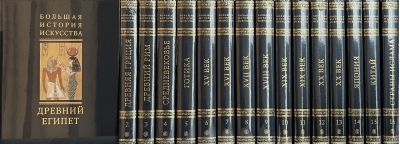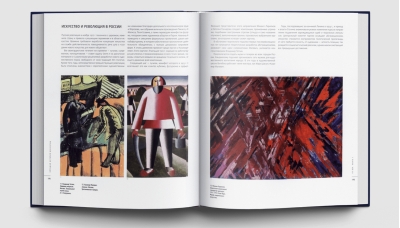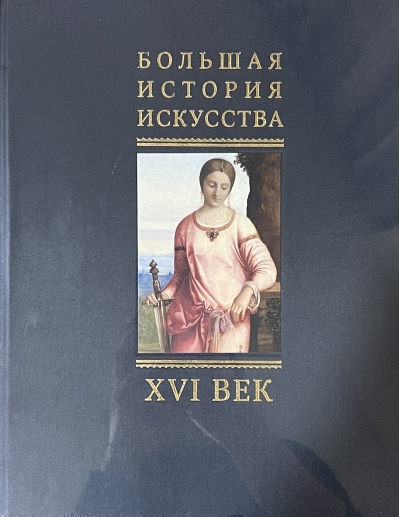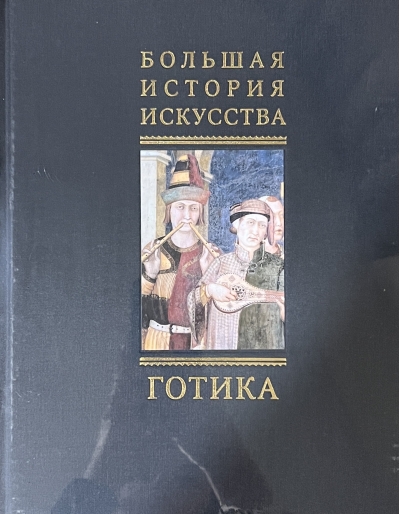A Great History of Art. In 16 Volumes
2,499.99 €
Out of stock
The Great History of Art is a rare opportunity to simultaneously collect all the necessary information to study the history of art of various epochs and countries. When purchasing such a collection of books, there is no need to independently compile such a library, buy disparate publications, check the reliability and quality of texts. The Great History of Art is a real gift, valuable and desirable, including to yourself. It is a decoration of any home library that can be inherited from generation to generation. The library will allow everyone to orient themselves in the amazing world of art, to give a layman a general idea of the subject, without overloading it with details.
The texts of the comments of the “Great History of Art” were written by leading Italian art historians and art historians, professors of the University of Florence (Alice Cartocci, Gloria Rosati, Cinzia Caiazzo, Giandomenico de Tommazo, Julia Marucci, Ricardo Belcari, Cristina Sirigatti, Marcella Anglani, etc.). Popular, democratic presentation of the material with its maximum informativeness turns the publication into a unique collection that has no analogues in the domestic book market. The Great History of Art is a collection of books that allows any person to learn to “read” the canvases of masters, without resorting to the help of a specialist, that is, independently master the skills of reading the plot, composition of the picture and analyzing the work - to become a real connoisseur and freely navigate the chosen topic. The Great History of Art is based on the principles of Sir Ernst Gombrich, whose fantastic success proves that the desire to engage the reader with words and images works only when the language of the narrative is clear and simple, and the information is reliable. The history of art is not a tedious series of facts, concepts or sophisticated theories; the history of art is a daring, exciting journey into the depths of epochs, to different peoples, this journey between monuments and paintings, technical techniques and styles, striking with a variety of sophistication and beauty. The 16-volume Library of the Great History of Art allows you to make such a journey not only thanks to fascinating texts written by famous art historians, but also a huge number of illustrations - and there are more than six and a half thousand! - giving you the opportunity to see this or that object, which is discussed in the pages of the book. Each volume of the Library contains a name index, chronology and bibliography, which, if desired, leaves the opportunity to expand and consolidate the knowledge gained.
Tom 1. Ancient Egyptian art:
3,500 years of Egyptian civilization
- Pyramids and statue of the Sphinx;
Paintings on the walls of tombs in the Valley of the Kings;
- The temples of Karnak and Luxor;
- In the Rock of the Colosseum of Ramesses II and Abu Simbel;
- Sculptor Tutmes - portraits of Akhenaten and Nefertiti;
- Objects of decorative and applied art.
Tom 2. The art of Ancient Greece:
3,000 years of Greek civilization
- Architecture of temples, theaters, Parthenon;
- Sculpture of marble and bronze;
- Sculptors Phidias, Polycletus, Myron, Praxiteles, Lysippus;
- Pergamon altar;
- Nika of Samothrace, Laocoon.
Volume 3. Art of Ancient Rome: VIII century BC - IV century AD;
- Architecture: triumphal arches and columns, palaces, thermals;
- Mosaics and wall paintings;
- Statues, bas-reliefs;
- Pantheon, Colosseum, forums;
- Pompeii?
- Fayum portraits;
- Architect Apollodorus;
- The first Christian temples.
Tom 4. Medieval art:
- IV-XIII centuries Europe;
Basilicas and mosaics of Rome, Byzantium, Ravenna;
- Carolingian Renaissance;
- Cathedrals in Durham, Leone, Modena, Palermo;
- Cathedral complex in Pisa, San Marco in Venice;
Baptistery in Florence and Parma;
- Sculptor Benedetto Antelami;
- Junta Pisano's crucifixion, Madonna and Child Cimabue.
Tom 5. Gothic:
- The middle of the XII-XIV centuries;
- The style was born in France and spread to Europe.
- Notre Dame and Sainte-Chapelle in Paris;
- Councils of England, Spain, Italy, Germany and Austria;
- Artists Duccio, Giotto, Simone Martini, Pietro and Ambrogio Lorenzetti;
- Sculptors Giovanni Pisano, Arnolfo di Cambio;
The Limburg Brothers: The Duke of Berry's Luxury Hours.
Vol 6. Art of the fifteenth century:
Late Gothic: Gentile da Fabriano and Pisanello
- Revival of Antiquity and Discovery of Perspective: Masaccio, Mantegna, Piero della Francesca, Bellini, Botticelli, Ghirlandaio under Lorenzo
- Magnificent in Flanders Jan van Eyck and Rogier van der Weyden;
- Architect Brunelleschi - the dome of the Florence Cathedral;
- Donatello's sculptures;
The Last Supper and the Madonna in the Rocks of Leonardo
- Bacchus and Michelangelo's Vatican Pieta.
Tom 7. XVI century art:
- Gioconda Leonardo, the Vatican Stanzas of Raphael;
Michelangelo – painting of the Sistine Chapel;
- Giorgione, Titian, Tintoretto, Durer;
- Bramante - the project of St. Peter's Cathedral;
1520 The Renaissance Crisis and the Birth of Mannerism
- Pontormo, Rosso Fiorentino, Giulio Romano, Bronzino;
- School of Fontainebleau in France, Escorial in Spain
- The sculptors Giambologna and Cellini;
- Vasari architects, Ammannati;
- The Council of Trent and the beginning of the Counter-Reformation - The Church dictates iron rules to artists.
Tom 8. Art of the seventeenth century:
Caravaggio Realism and Poussin Classicism
- Rembrandt, Vermer;
- Baroque: Rubens, Van Dyck, Luca Giordano, Pietro da Cortona
- In Spain, El Greco, Velázquez, Zurbaran;
- Architect and sculptor Bernini, architect Borromini in Rome;
- Palladio's villas and palaces;
- Palace and Park Ensemble in Versailles;
Christopher Wren is St. Paul's Cathedral in London.
Tom 9. Eighteenth-century art:
- Later Baroque, Rococo, the birth of neoclassicism;
- Galant scenes Watteau, Boucher, Fragonard;
- Tiepolo frescoes, led by Canaletto, Belotto, Guardi;
Portraits of Reynolds, Romney, Gainsborough;
- Sculptors Houdon, Falcone, Schlüter;
- Winter Palace in St. Petersburg, Sanssouci in Berlin, Schönbrunn in Vienna, the Royal Palace in Madrid;
- The era of the creation of museums: the Louvre, the Hermitage, the Pio Museum, Clementino (Rome).
Tom 10. Nineteenth century art. Book 1:
- Triumph of Napoleon and associated Empire style (David, Canova), Goya;
Romanticism: Turner, Friedrich, Géricault, Delacroix, Courbet;
- Landscapes of Corot, everyday writing by Millet and satire by Daumier;
- Pre-Raphaelites in England;
- Neoclassicism of Ingres;
- Repin and Kramsky realism.
Tom 11. Nineteenth century art. Book 2:
Impressionism: Monet, Manet, Renoir, Degas, Pissarro;
- Cezanne as a forerunner of the main artistic trends of the XX century;
Postimpressionism: Toulouse-Lautrec, Van Gogh, Gauguin
- The birth of Art Nouveau (modern) style;
- Gustav Klimt, Valentin Serov;
Eiffel Tower, the first skyscrapers in New York
- Sculptors Auguste Rodin, Medardo Rosso.
Tom 12. XX century art. Book 1:
- The period before the Second World War;
- French Fauvism: Matisse, Vlaminck, Marche, Derain;
German Expressionism: Kirchner, Pechstein, Nolde;
- Italian and Russian Futurism;
Picasso as the founder of modern art;
Cubism (Picasso, Marriage), metaphysical painting (De Chirico);
- The birth of abstractionism (Kandinsky, Malevich);
Constructivism: Tatlin, Rodchenko;
- Surrealism: Klee, Miro, Dali.
Tom 13. XX century art. Book 2:
- After the Second World War, the time of informative art;
Francis Bacon and Lucien Freud – Fear and Despair
- Pollock's drip method;
- Magritte's surrealism;
- Assemblies from consumer goods, scrap and garbage;
- Andy Warhol is a symbol of pop art.
- Sculptor Henry Moore;
- Architects Oscar Niemeyer, Le Corbusier, Eero Saarinen, Norman Foster.
Tom 14. Art of Japan:
- From antiquity to the present day;
- Close connection of art with religion - Buddhism and Confucianism;
- Temples, pagodas, sanctuaries;
- Masks of the No theatre;
- Japanese dwelling and miniature gardens;
- Kimono and Netske, tea ceremonies;
- Artists Ogata Kenzan, Katsushika Hokusai, Hisikawa Moronobu;
- Calligraphy and woodcutting.
Tom 15. Art of China:
- From antiquity to the beginning of the nineteenth century;
- The famous Terracotta Army;
- Confucianism, Taoism, Buddhism – influence on art;
- Monumental architectural complexes, rock monasteries;
- Temple wall paintings;
- Production of porcelain and silk and painting of products from them;
- The art of calligraphy, the appearance of easel painting;
- Artists Gu Kaiji, Hu Gui, Guo Xi, Fan Kuan, Huizong, Wang Min.
Tom 16. Art of the countries of Islam:
- Colossal territory of distribution: Spain, North Africa, Egypt, Syria, Iraq, Iran, Turkey, Mongolia, Afghanistan, India, Caucasus;
- IX-XVIII centuries;
- Grand mosques, high minarets, madrassas;
- Arabic ornamentation;
- Book miniatures, design of the Quran;
- Bright mosaics;
- Luxury and brilliance of the palaces of rulers;
- Mosque in Cordoba;
- Taj Mahal in Agra;
- Alhambra in Granada.
The texts of the comments of the “Great History of Art” were written by leading Italian art historians and art historians, professors of the University of Florence (Alice Cartocci, Gloria Rosati, Cinzia Caiazzo, Giandomenico de Tommazo, Julia Marucci, Ricardo Belcari, Cristina Sirigatti, Marcella Anglani, etc.). Popular, democratic presentation of the material with its maximum informativeness turns the publication into a unique collection that has no analogues in the domestic book market. The Great History of Art is a collection of books that allows any person to learn to “read” the canvases of masters, without resorting to the help of a specialist, that is, independently master the skills of reading the plot, composition of the picture and analyzing the work - to become a real connoisseur and freely navigate the chosen topic. The Great History of Art is based on the principles of Sir Ernst Gombrich, whose fantastic success proves that the desire to engage the reader with words and images works only when the language of the narrative is clear and simple, and the information is reliable. The history of art is not a tedious series of facts, concepts or sophisticated theories; the history of art is a daring, exciting journey into the depths of epochs, to different peoples, this journey between monuments and paintings, technical techniques and styles, striking with a variety of sophistication and beauty. The 16-volume Library of the Great History of Art allows you to make such a journey not only thanks to fascinating texts written by famous art historians, but also a huge number of illustrations - and there are more than six and a half thousand! - giving you the opportunity to see this or that object, which is discussed in the pages of the book. Each volume of the Library contains a name index, chronology and bibliography, which, if desired, leaves the opportunity to expand and consolidate the knowledge gained.
Tom 1. Ancient Egyptian art:
3,500 years of Egyptian civilization
- Pyramids and statue of the Sphinx;
Paintings on the walls of tombs in the Valley of the Kings;
- The temples of Karnak and Luxor;
- In the Rock of the Colosseum of Ramesses II and Abu Simbel;
- Sculptor Tutmes - portraits of Akhenaten and Nefertiti;
- Objects of decorative and applied art.
Tom 2. The art of Ancient Greece:
3,000 years of Greek civilization
- Architecture of temples, theaters, Parthenon;
- Sculpture of marble and bronze;
- Sculptors Phidias, Polycletus, Myron, Praxiteles, Lysippus;
- Pergamon altar;
- Nika of Samothrace, Laocoon.
Volume 3. Art of Ancient Rome: VIII century BC - IV century AD;
- Architecture: triumphal arches and columns, palaces, thermals;
- Mosaics and wall paintings;
- Statues, bas-reliefs;
- Pantheon, Colosseum, forums;
- Pompeii?
- Fayum portraits;
- Architect Apollodorus;
- The first Christian temples.
Tom 4. Medieval art:
- IV-XIII centuries Europe;
Basilicas and mosaics of Rome, Byzantium, Ravenna;
- Carolingian Renaissance;
- Cathedrals in Durham, Leone, Modena, Palermo;
- Cathedral complex in Pisa, San Marco in Venice;
Baptistery in Florence and Parma;
- Sculptor Benedetto Antelami;
- Junta Pisano's crucifixion, Madonna and Child Cimabue.
Tom 5. Gothic:
- The middle of the XII-XIV centuries;
- The style was born in France and spread to Europe.
- Notre Dame and Sainte-Chapelle in Paris;
- Councils of England, Spain, Italy, Germany and Austria;
- Artists Duccio, Giotto, Simone Martini, Pietro and Ambrogio Lorenzetti;
- Sculptors Giovanni Pisano, Arnolfo di Cambio;
The Limburg Brothers: The Duke of Berry's Luxury Hours.
Vol 6. Art of the fifteenth century:
Late Gothic: Gentile da Fabriano and Pisanello
- Revival of Antiquity and Discovery of Perspective: Masaccio, Mantegna, Piero della Francesca, Bellini, Botticelli, Ghirlandaio under Lorenzo
- Magnificent in Flanders Jan van Eyck and Rogier van der Weyden;
- Architect Brunelleschi - the dome of the Florence Cathedral;
- Donatello's sculptures;
The Last Supper and the Madonna in the Rocks of Leonardo
- Bacchus and Michelangelo's Vatican Pieta.
Tom 7. XVI century art:
- Gioconda Leonardo, the Vatican Stanzas of Raphael;
Michelangelo – painting of the Sistine Chapel;
- Giorgione, Titian, Tintoretto, Durer;
- Bramante - the project of St. Peter's Cathedral;
1520 The Renaissance Crisis and the Birth of Mannerism
- Pontormo, Rosso Fiorentino, Giulio Romano, Bronzino;
- School of Fontainebleau in France, Escorial in Spain
- The sculptors Giambologna and Cellini;
- Vasari architects, Ammannati;
- The Council of Trent and the beginning of the Counter-Reformation - The Church dictates iron rules to artists.
Tom 8. Art of the seventeenth century:
Caravaggio Realism and Poussin Classicism
- Rembrandt, Vermer;
- Baroque: Rubens, Van Dyck, Luca Giordano, Pietro da Cortona
- In Spain, El Greco, Velázquez, Zurbaran;
- Architect and sculptor Bernini, architect Borromini in Rome;
- Palladio's villas and palaces;
- Palace and Park Ensemble in Versailles;
Christopher Wren is St. Paul's Cathedral in London.
Tom 9. Eighteenth-century art:
- Later Baroque, Rococo, the birth of neoclassicism;
- Galant scenes Watteau, Boucher, Fragonard;
- Tiepolo frescoes, led by Canaletto, Belotto, Guardi;
Portraits of Reynolds, Romney, Gainsborough;
- Sculptors Houdon, Falcone, Schlüter;
- Winter Palace in St. Petersburg, Sanssouci in Berlin, Schönbrunn in Vienna, the Royal Palace in Madrid;
- The era of the creation of museums: the Louvre, the Hermitage, the Pio Museum, Clementino (Rome).
Tom 10. Nineteenth century art. Book 1:
- Triumph of Napoleon and associated Empire style (David, Canova), Goya;
Romanticism: Turner, Friedrich, Géricault, Delacroix, Courbet;
- Landscapes of Corot, everyday writing by Millet and satire by Daumier;
- Pre-Raphaelites in England;
- Neoclassicism of Ingres;
- Repin and Kramsky realism.
Tom 11. Nineteenth century art. Book 2:
Impressionism: Monet, Manet, Renoir, Degas, Pissarro;
- Cezanne as a forerunner of the main artistic trends of the XX century;
Postimpressionism: Toulouse-Lautrec, Van Gogh, Gauguin
- The birth of Art Nouveau (modern) style;
- Gustav Klimt, Valentin Serov;
Eiffel Tower, the first skyscrapers in New York
- Sculptors Auguste Rodin, Medardo Rosso.
Tom 12. XX century art. Book 1:
- The period before the Second World War;
- French Fauvism: Matisse, Vlaminck, Marche, Derain;
German Expressionism: Kirchner, Pechstein, Nolde;
- Italian and Russian Futurism;
Picasso as the founder of modern art;
Cubism (Picasso, Marriage), metaphysical painting (De Chirico);
- The birth of abstractionism (Kandinsky, Malevich);
Constructivism: Tatlin, Rodchenko;
- Surrealism: Klee, Miro, Dali.
Tom 13. XX century art. Book 2:
- After the Second World War, the time of informative art;
Francis Bacon and Lucien Freud – Fear and Despair
- Pollock's drip method;
- Magritte's surrealism;
- Assemblies from consumer goods, scrap and garbage;
- Andy Warhol is a symbol of pop art.
- Sculptor Henry Moore;
- Architects Oscar Niemeyer, Le Corbusier, Eero Saarinen, Norman Foster.
Tom 14. Art of Japan:
- From antiquity to the present day;
- Close connection of art with religion - Buddhism and Confucianism;
- Temples, pagodas, sanctuaries;
- Masks of the No theatre;
- Japanese dwelling and miniature gardens;
- Kimono and Netske, tea ceremonies;
- Artists Ogata Kenzan, Katsushika Hokusai, Hisikawa Moronobu;
- Calligraphy and woodcutting.
Tom 15. Art of China:
- From antiquity to the beginning of the nineteenth century;
- The famous Terracotta Army;
- Confucianism, Taoism, Buddhism – influence on art;
- Monumental architectural complexes, rock monasteries;
- Temple wall paintings;
- Production of porcelain and silk and painting of products from them;
- The art of calligraphy, the appearance of easel painting;
- Artists Gu Kaiji, Hu Gui, Guo Xi, Fan Kuan, Huizong, Wang Min.
Tom 16. Art of the countries of Islam:
- Colossal territory of distribution: Spain, North Africa, Egypt, Syria, Iraq, Iran, Turkey, Mongolia, Afghanistan, India, Caucasus;
- IX-XVIII centuries;
- Grand mosques, high minarets, madrassas;
- Arabic ornamentation;
- Book miniatures, design of the Quran;
- Bright mosaics;
- Luxury and brilliance of the palaces of rulers;
- Mosque in Cordoba;
- Taj Mahal in Agra;
- Alhambra in Granada.
See also:
- All books by the publisher











































































